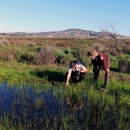What We Do
Recovery Planning
In order to promote and support the conservation and survival of endangered species and threatened species, and provide a transparent path to achieving recovery, we and our partners develop and implement recovery plans. Recovery plans are unique to each species and serve as central organizing tools that provide important guidance on methods of minimizing threats to listed species, such as restoring and acquiring habitat, removing introduced predators or invasive species invasive species
An invasive species is any plant or animal that has spread or been introduced into a new area where they are, or could, cause harm to the environment, economy, or human, animal, or plant health. Their unwelcome presence can destroy ecosystems and cost millions of dollars.
Learn more about invasive species , conducting surveys, monitoring individual populations, and breeding species in captivity and releasing them into their historical range. Recovery plans identify measurable and objective criteria against which progress toward recovery of a species can be tracked over time. Recovery plans are guidance and not regulatory documents, and no agency or entity is required by the Endangered Species Act (ESA) to implement actions in a recovery plan.
Learn more about recovery planning and implementation.
Search the database for available recovery plans and draft recovery plans available for public review and comment.
Five-year Reviews
In order to assess ongoing conservation efforts and ensure that species are appropriately classified under the ESA, we conduct periodic status reviews of each listed species at least once every five years. A five-year review evaluates available information to determine whether a species status has changed since the time of its listing or its last status review and assess its progress toward recovery. These reviews assist us and our partners in identifying conservation needs and better targeting and prioritizing conservation efforts for federally listed species.
Learn more about five-year reviews.
View the report for species with five-year status reviews.
Learn more about the process used in determining a species' status under the ESA.









